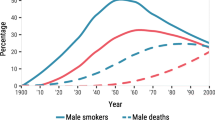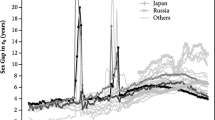Abstract
This article demonstrates that over the period 1948–2003, sex differences in mortality in the age range 50–84 widened and then narrowed on a cohort basis rather than on a period basis. The cohort with the maximum excess of male mortality was born shortly after the turn of the century. Three separate data sources suggest that the turnaround in sex mortality differences is consistent with sex differences in cigarette smoking by cohort. An age-period-cohort model reveals a highly significant effect of smoking histories on men’s and women’s mortality. Combined with recent changes in smoking patterns, the model suggests that sex differences in mortality will narrow dramatically in coming decades.
Similar content being viewed by others
References
Bongaarts, J. 2006. “How Long Will We Live?” Unpublished manuscript. The Population Council, New York.
Burns, D.M., L. Lee, L.Z. Shen, E. Gilpin, H.D. Tolley, J. Vaughn, and T.G. Shanks. 1998a.“Cigarette Smoking Behavior in the United States.” Pp. 13–112 in Changes in Cigarette-Related Disease Risks and Their Implication for Prevention and Control, edited by D.M. Burns, L. Garfinkel, and J. Samet. Smoking and Tobacco Control Monograph No. 8. Bethesda, MD: Cancer Control and Population Sciences, National Cancer Institute, U.S. National Institutes of Health.
Burns, D.M., T.G. Shanks, W. Choi, M.J. Thun, C.W. Heath, and L. Garfinkel. 1998b. “The American Cancer Society Cancer Prevention Study I: 12-Year Follow-up of 1 Million Men and Women.” Pp. 113–304 in Changes in Cigarette-Related Disease Risks and Their Implication for Prevention and Control, edited by D.M. Burns, L. Garfinkel, and J. Samet. Smoking and Tobacco Control Monograph No. 8. Bethesda, MD: Cancer Control and Population Sciences, National Cancer Institute, U.S. National Institutes of Health.
Cutler, D. 2004. Your Money or Your Life. Oxford: Oxford University Press.
Department of Health, Education, and Welfare. 1964. Smoking and Health: Report of the Advisory Committee to the Surgeon General of the Public Health Service. PHS Publication No. 1103. U.S. Department of Health, Education, and Welfare, Public Health Service, Rockville, MD.
Gjonca, A., C. Tomassini, B. Toson, and S. Smallwood. 2005. “Sex Differences in Mortality, A Comparison of the United Kingdom and Other Developed Countries.” Health Statistics Quarterly 26(Summer):6–16.
Haenszel, W., M.B. Shimkin, and H.P. Miller. 1956. Tobacco Smoking Patterns in the United States. Washington, DC: U.S. Government Printing Office.
Janssen, F. and A.E. Kunst. 2005. “Cohort Patterns in Mortality Trends Among the Elderly in Seven European Countries, 1950–99.” International Journal of Epidemiology 34:1149–59.
Kannisto, V. 1994. Development of Oldest-Old Mortality, 1950–1990: Evidence From 28 Developed Countries. Odense, Denmark: University of Odense Press.
Kermack, W.O., A.G. McKendrick, and P.L. McKinlay. 1934. “Death Rates in Great Britain and Sweden: Some Regularities and Their Significance.” The Lancet 31:698–703.
Knoke, J.D., T.G. Shanks, J.W. Vaughn, M.J. Thun, and D.M. Burns. 2004. “Lung Cancer Mortality Is Related to Age in Addition to Duration and Intensity of Cigarette Smoking: An Analysis of CPS-I Data.” Cancer Epidemiology Biomarkers and Prevention 13:949–57.
Mason, W.M. and H.L. Smith. 1985. “Age-Period-Cohort Analysis and the Study of Deaths From Pulmonary Tuberculosis.” Pp. 151–227 in Cohort Analysis in Social Research: Beyond the Identification Problem, edited by W.M. Mason and S.E. Fienberg. New York: Springer-Verlag.
National Center for Health Statistics. 2004. “United States Life Tables, 2002.” National Vital Statistics Reports, Vol. 53, No. 6. Hyattsville, MD: National Center for Health Statistics, Center for Disease Control and Prevention.
—. 2005. “Deaths: Preliminary Data for 2003.” National Vital Statistics Reports, Vol. 53, No. 15. Hyattsville, MD: National Center for Health Statistics, Center for Disease Control and Prevention.
National Research Council, Panel on Population Projections. 2000. Beyond Six Billion. Washington, DC: National Academies Press.
Pampel, F.C. 2002. “Cigarette Use and the Narrowing Sex Differential in Mortality.” Population and Development Review 28:77–104.
— 2005. “Forecasting Sex Differences in Mortality in High Income Nations: The Contribution of Smoking.” Demographic Research 13:455–84.
Peto, R., A.D. Lopez, J. Boreham, M. Thun, and C. Heath, Jr. 1994. Mortality From Smoking in Developed Countries 1950–2000: Indirect Estimates From National Vital Statistics. Oxford: Oxford University Press.
Preston, S.H. 1970. Older Male Mortality and Cigarette Smoking: A Demographic Analysis. Berkeley: Institute of International Studies, University of California.
Retherford, R.D. 1975. The Changing Sex Differential in Mortality. Westport, CT: Greenwood Press.
Rogers, R.G., R.A. Hummer, P.M. Krueger, and F.C. Pampel. 2005. “Mortality Attributable to Cigarette Smoking in the United States.” Population and Development Review 31:259–92.
Sytkowski, P.A., R.B. D’Agostino, A.J. Belanger, and W.B. Kannel. 1996. “Secular Trends in Longterm Sustained Hypertension, Long-term Treatment, and Cardiovascular Mortality: The Framingham Heart Study 1950 to 1990.” Circulation 93:697–703.
Taylor, D.H., V. Hasselblad, J. Henley, M.J. Thun, and F.A. Sloan. 2002. “Benefits of Smoking Cessation for Longevity.” American Journal of Public Health 92:990–96.
Thun, M.J., C. Day-Lally, D.G. Myers, E.E. Calle, W.D. Flanders, B.-P. Zhu, M.M. Namboodiri, and C.W. Heath. 1998. “Trends in Tobacco Smoking and Mortality From Cigarette Use in Cancer Prevention Studies I (1959 Through 1965) and II (1982 Through 1988).” Pp. 305–82 in Changes in Cigarette-Related Disease Risks and Their Implication for Prevention and Control, edited by D.M. Burns, L. Garfinkel, and J. Samet. Smoking and Tobacco Control Monograph No. 8. Bethesda, MD: Cancer Control and Population Sciences, National Cancer Institute, U.S. National Institutes of Health.
Tolley, H.D., L. Crane, and N. Shipley. 1991. “Smoking Prevalence and Lung Cancer Death Rates.” Pp. 73–144 in Strategies to Control Tobacco Use in the United States: A Blueprint for Public Health Action in the 1990’s. NIH Publication 92-3316. National Institutes of Health, Bethesda, MD.
Tunstall-Pedoe, H., D. Vanuzzo, M. Hobbs, M. Mahonen, Z. Cepaitis, K. Kuulasmaa, and U. Keil. 2000. “Estimation of Contribution of Changes in Coronary Care to Improving Survival, Event Rates, and Coronary Heart Disease Mortality Across the WHO MONICA Project Populations.” The Lancet 355:688–700.
Valkonen, T. and F. van Poppel. 1997. “The Contribution of Smoking to Sex Differences in Life Expectancy: Four Nordic Countries and the Netherlands, 1970–1989.” European Journal of Public Health 7:302–10.
Waldron, I. 1986. “The Contribution of Smoking to Sex Differences in Mortality.” Public Health Reports 101:163–73.
Wilmoth, J.R. 2005. “Some Methodological Issues in Mortality Projection, Based on an Analysis of the U.S. Social Security System.” Genus XLI(1):179–211.
Author information
Authors and Affiliations
Additional information
This project was supported by National Institute of Aging Grant P30 AG12836 and by the Boettner Center for Pensions and Retirement Security at the University of Pennsylvania. We are grateful to Donna Hoyert from the National Center for Health Statistics and to David M. Burns of the University of California, San Diego, for supplying certain of the data on which this study is based. We appreciate the comments and suggestions of John Bongaarts, Douglas Ewbank, Hans-Peter Kohler, and editors and reviewers for this journal.
Rights and permissions
About this article
Cite this article
Preston, S.H., Wang, H. Sex mortality differences in The United States: The role of cohort smoking patterns. Demography 43, 631–646 (2006). https://doi.org/10.1353/dem.2006.0037
Issue Date:
DOI: https://doi.org/10.1353/dem.2006.0037




